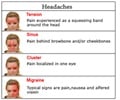Effective relief to millions of headache sufferers around the world might be on the way in years to come.
Effective relief to millions of headache sufferers around the world might be on the way in years to come.
That's because the International Headache Society has just published new research guidelines intended to stimulate more research into headache treatment, and to provide researchers with guidelines to cut health risks associated with treatment. The guidelines appear in the latest issue of Cephalalgia (http:cep.sagepub.com/current.dtl#GUIDELINES), now published by SAGE.Dr Lars Bendtsen and his team from the Clinical Trials Standing Committee of the International Headache Society in Copenhagen, Denmark developed new recommendations on how to improve the quality and safety of the research into treatments for episodic and chronic tension-type headaches. The guidelines will enhance clinical trial safety for patients, and will also allow researchers to determine if older drugs still used to treat tension-type headaches are as effective and safe as they should be.
The last research guidelines for tension-type headache research were published in 1995, but few novel or evidence-based treatment options have become available since that time. Focusing specifically on episodic tension-type headaches (ETTH) and chronic tension-type headaches (CTTH), Bendtsen's goal is to spur new research into the treatment of these commonly occurring headaches. This includes analgesics for episodic headaches as well as preventative treatments for chronic headache sufferers.
Millions of people suffer from ETTH, which can range in frequency from a few times a year to 14 times a month. Many people suffer from CTTH, which can be debilitating. The treatments for these can vary profoundly depending on the severity of the condition.
Over the years, research has found that analgesics - otherwise known as pain-relievers - are usually the most effective way of treating all but the most severe episodic headaches. However, severe episodic headaches and CTTH will often benefit from preventative treatments, which is usually the most effective way of providing lasting relief. Researchers have also found that chronic headache sufferers seldom benefit from analgesics.
Given the many kinds of headache medications available today, and the frequency with which these pain relievers and other treatments are used, new research into tension-related headache treatments will have a great impact on public health. Numerous studies have established that frequent use of analgesics for episodic headaches can increase the risk of side-effects, and can even lead to kidney and liver problems over time. Therefore, identifying more effective treatments for headache sufferers will allow physicians to be more targeted in their choice of drugs. Ultimately, this will translate into a more pain-free life for the tens of millions of people around the world suffering from occasional and chronic tension-type headaches.
Advertisement
Source-Eurekalert
RAS









